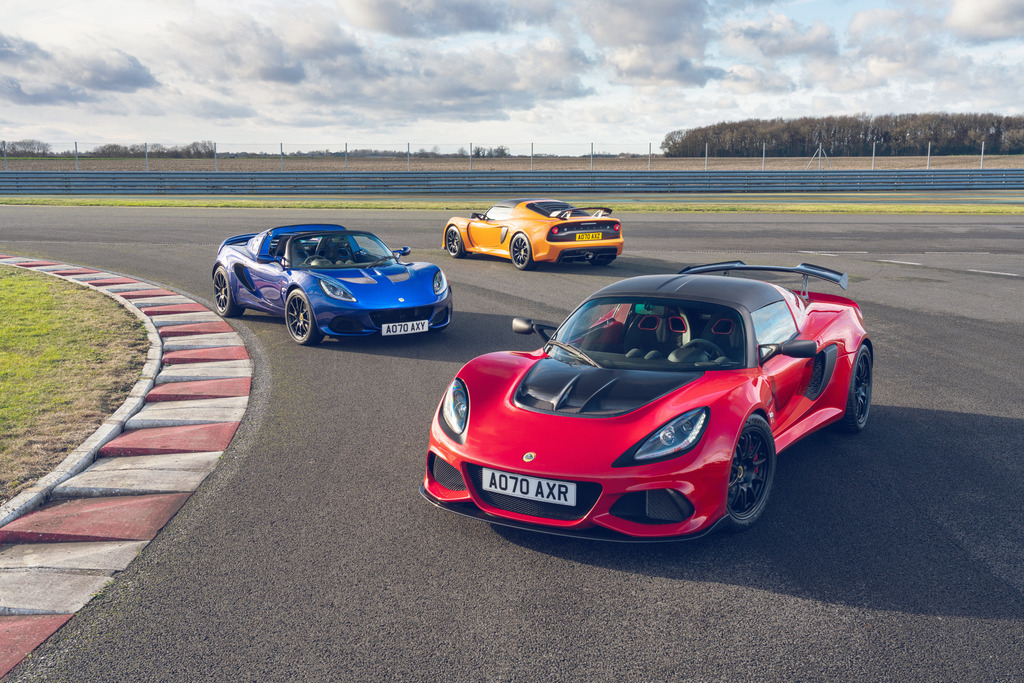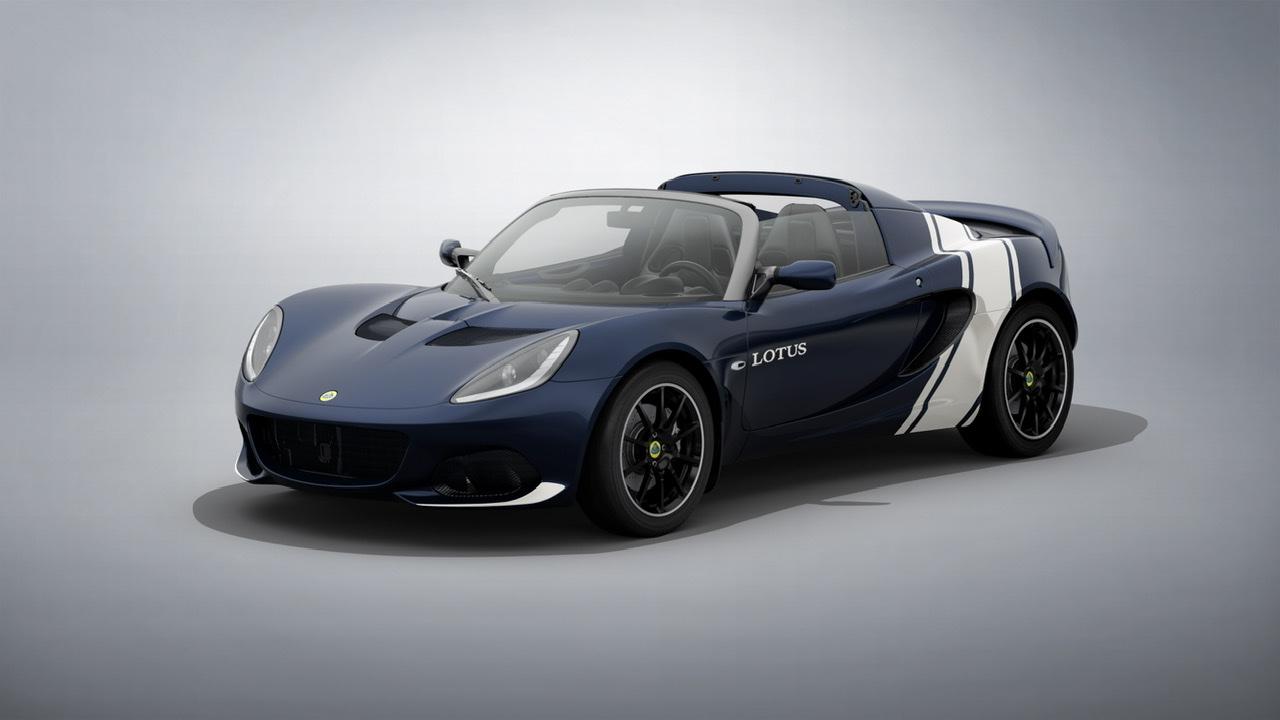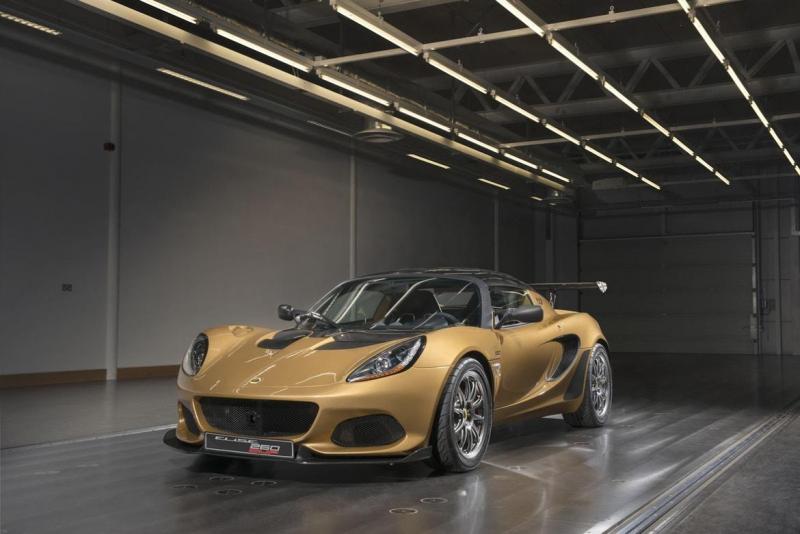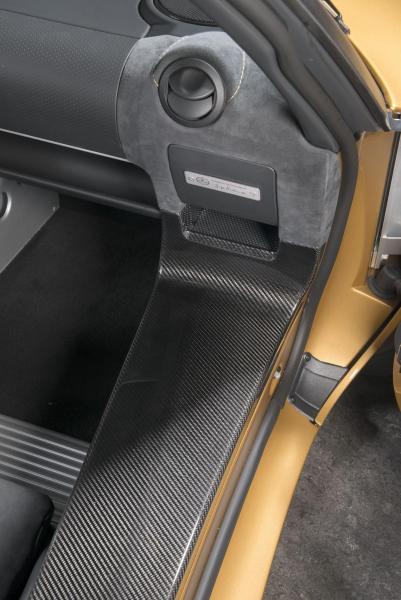Cerca nel Forum
Mostra i risultati del/dei TAG ''elise'' .
Trovato 6 risultati
-
(Hethel, UK – 22 December 2021) Today, Lotus commemorates the last of the Elise, Exige and Evora sports cars. The trio were photographed on site with many of the Lotus team who contributed to the design, engineering, assembly and sales of the cars. Between these three model lines and over the course of 26 years, a total of 51,738 cars will have come off the production line. Combined, they represent almost half of the total production of Lotus in its 73-year history. In addition, 9,715 sports cars were built for Lotus’ third-party clients, including GM and Tesla. From 1996 to 2000, the first-generation Elise and Exige sports cars were built in a small assembly hall at Hethel alongside the Lotus Esprit. The current assembly lines, which were installed in 2000, will be dismantled and replaced with all-new state-of-the-art facilities in support of the all-new Emira factory. Full Emira production begins in the spring, after the prototype and test phases currently underway are completed, taking Lotus sports car production into an exciting, high-tech and semi-automated era, and increasing capacity up to 5,000 units per year on a single shift pattern. The last examples of the Elise, Exige and Evora models are reserved for Lotus’ growing heritage collection. Joining the collection will be the last Elise, a Sport 240 Final Edition finished in Yellow and the last of 35,124 cars; the last Exige, a Cup 430 Final Edition in Heritage Racing Green – number 10,497; and the last Evora – a GT430 Sport finished in Dark Metallic Grey – the last of a production run of 6,117. The Elise and Exige sports cars are built around the Lotus ‘small car platform’. On the same platform, and also manufactured by Lotus at Hethel were the Opel Speedster / Vauxhall VX220 (7,200 cars built between 2000 and 2005) and the Tesla Roadster (2,515 cars built between 2007 and 2012). Therefore, including the Lotus 340R, Europa, 2-Eleven and 3-Eleven cars, this brings the total Lotus small car platform production volumes to 56,618 cars. Matt Windle, Managing Director, Lotus Cars, said: “First of all, I would like to thank the Lotus team who have worked on the Elise, Exige and Evora over the years and who are now transferring to Emira and Evija manufacturing. I would also like to convey enormous gratitude to all the customers of the Elise, Exige and Evora over the last 26 years for their passion, enthusiasm and support. These customers have given our ‘three Es’ true cult status – usually reserved for long-out-of-production classics. As we say farewell to the last few cars, we look forward to the Emira and Evija in the all-new factories at Hethel and sub-assembly facilities in Norwich, which introduce greater efficiencies and automation, higher quality and flexibility and the hugely exciting next chapter in our Vision80 strategy.” Russell Carr, Design Director, Lotus Cars, added: “These iconic cars have not only played a huge role in Lotus’ 73-year history but have also been ever-present in my daily life. Together with the Lotus design team, I have lived and breathed these cars for over 26 years. We will miss them, but a bit like Christmas, once it’s over, the excitement for the next one starts to build – and that’s what’s happening now at Lotus with the Evija, Emira and forthcoming Type 132. 2022 is going to be a great year as a new Lotus generation swings into action.” Gavan Kershaw, Director of Vehicle Attributes, said: “The Elise, particularly, has been a huge part of my life. It was conceived when I had just finished my apprenticeship and I was working in the vehicle workshops helping to build early prototypes. The Exige will always remain close to me, as the development programme was the first that I worked on as an engineer and I also won the British GT3 championship in a race version. The Evora is also hugely important as it showed that you can have high performance and award-winning handling without sacrificing the longer-journey GT ability. I have first-hand experience of this as I won the British GT4 championships in one and I will never forget leading the technical programme for our Evora Le Mans campaign where we achieved a podium.” Richard Rackham, Head of Vehicle Concepts, who was vehicle architect on the Lotus Elise and part of the team that pioneered extruded and bonded aluminium technology in the automotive industry, said: “The impact of these three cars has been spectacular over the years, technically, structurally and dynamically. But all technologies and innovations move on and, if you had asked me of my proudest moment four years ago, I would have, without hesitation, said the Elise chassis. However, this has been usurped by our new Project LEVA architecture for our new range of electric sports cars, starting with the Type 135 in a few years’ time. This is now the zenith of Lotus architectures as it has moved the technology game so much further. There is a lot to look forward to.” The elder of the ‘3Es’ trio, the Elise, has been part of the automotive landscape for more than 25 years. Click here for 25 examples of the huge impact and lasting legacy of this amazing little two-seater. Next out of the Lotus stable is the Emira, the critically acclaimed new mid-engineered sports car from Lotus. Launched last July at Hethel and on a world tour ever since, it’s the last petrol-powered car from Lotus. Joining the first electric Lotus – the Evija hypercar and the most powerful production car in the world – will be the all-electric Type 132, Lotus’ first SUV, which will be revealed to the world in the spring.
-

Lotus Elise e Exige Final Edition 2021
nella discussione ha aggiunto nicogiraldi in Presentazioni Nuovi Modelli
(Hethel, UK – 8 February 2021) – This year marks the end of an era for Lotus Cars. As the business moves towards an exciting future as outlined in recent announcements, time is being called on production of the iconic Elise and the genre-creating Exige, after 25 and 21 years respectively. In honour of these two legendary models, Lotus has announced a range of five new Final Edition cars which have higher power, greater standard specification and – in true Lotus style – light weight. These cars are the ultimate versions of the Elise and Exige, and mark the pinnacle of technical development to showcase more than two decades of engineering excellence. To be built in limited numbers, each is a fitting tribute to performance cars that are, almost uniquely, legends in their own lifetime. Five new variants – two Elise and three Exige – have been created and Lotus is anticipating high demand from global markets as customers rush to buy a slice of history. They are available with unique paint colours, new exterior decals, new wheel finishes, new trim and Final Edition badging. The improvements continue under the skin, a fact reflected in new names which reveal higher power outputs on three of the five – the Elise Sport 240, Elise Cup 250, Exige Sport 390, Exige Sport 420 and Exige Cup 430. The Elise and Exige Final Edition cars are on sale now, with the MSRP for selected markets listed below. For other markets please contact the appropriate official Lotus Cars importer. Italy(inc VAT) Elise Sport 240 € 60,290 Elise Cup 250 € 67,940 Exige Sport 390 € 84,290 Exige Sport 420 € 104,460 Exige Cup 430 € 134,660 As revealed last month, the Lotus Evora has also entered its final year of production. Further announcements about plans to celebrate this model will be announced in due course. The Lotus Elise Final Edition range in detail The Elise is a truly iconic Lotus, with 2021 serving as the 25th and final year of production. These two new Final Edition cars are a fitting tribute, and the exclusivity and rarity will no doubt ensure high demand and guarantee future classic status. They retain all the core values and features that have made the Elise such an iconic car – a small, light and agile two-seater powered by a supercharged and chargecooled 1.8-litre, four-cylinder mid-mounted engine. As standard, both Final Edition cars receive the most extensive list of interior and exterior features ever. The biggest change is the all-new TFT digital dashboard with the choice of two screens, one with a conventional set of dials and the other a race car-style with digital speed read-out and an engine speed bar. The steering wheel is of a new design and clad in leather and alcantara. It features a flat base to create better leg clearance for taller drivers and to aid ingress and egress. Every car comes with a Final Edition build plaque, plus new seat trim and stitch patterns. A new selection of colours has been introduced for both the Elise Sport 240 and the Elise Cup 250, harking back to some of the iconic colour schemes from the Elise and Lotus’ past. These include Azure Blue, the colour used in the first production car images for media in 1996; Black, the brand colour of the motorsport division when the company ran the successful Autobytel Lotus Elise Championship race series; and Racing Green, an homage to the colour of the original car unveiled at the 1995 Frankfurt Motor Show. Lotus Elise Sport 240 Final Edition The Elise Sport 240 Final Edition gains an extra 23bhp from a revised calibration and so replaces the Sport 220. Delivering 240bhp and 244Nm of torque, the engine has been tuned to provide stunning real-world performance and class-leading efficiency. The 0-60mph sprint is completed in 4.1 seconds thanks to a power-to-weight ratio of 260bhp per tonne. CO2 emissions of 177 g/km are extremely low for the performance on offer. The car comes with 10-spoke Anthracite lightweight forged alloy wheels as standard (6J x 16” front and 8J x 17” rear). They’re 0.5kg lighter than the wheels on the Elise Sport 220 and shod with Yokohama V105 tyres (195/50 R16 front and 225/45 R17 rear). Further weight savings can be achieved with an extensive range of optional carbon fibre panels, including sill covers and engine cover, lithium-ion battery plus a lightweight polycarbonate rear window. With all the lightweight options chosen, the mass of the Elise Sport 240 reduces further from 922kg to 898kg. Lotus Elise Cup 250 Final Edition Key to the Elise Cup 250’s performance are its aerodynamics and downforce linked to its power and light weight. With aerodynamically optimised components such as the front splitter, rear wing, rear diffuser and side floor extension, this Final Edition car produces 66kg of downforce at 100mph and 155kg of downforce at is maximum speed of 154mph. The car is shod in new 10-spoke Diamond Cut ultra-lightweight M Sport forged wheels (7J x 16” front and 8J x 17” rear) with Yokohama A052 tyres (195/50 R16 front and 225/45 R17 rear). The extensive list of standard equipment includes Bilstein sport dampers and adjustable anti-roll bars, to help maximise the aerodynamic downforce available and boost grip whilst maintaining the legendary Elise handling. Also fitted as standard is a lightweight lithium-ion battery and polycarbonate rear window. Other lightweight carbon fibre options, as on the Elise Sport 240 Final Edition, are available reducing the mass to an unladen weight of just 931kg. The Lotus Exige Final Edition range in detail The Exige range is celebrated in its final year of production with three new models – the Exige Sport 390, Exige Sport 420 and Exige Cup 430. Like the Elise, new equipment for this final year of production includes unique paint choices, new decals and two new wheel finishes. All versions of the Exige also come with the TFT digital dashboard, Final Edition build plaque, new steering wheel, plus new seat trim and stitch patterns. All models are powered by a 3.5-litre supercharged V6 with a baffled sump, mounted in a lightweight and rigid chassis that provides thrilling acceleration and instant response. Pure unassisted steering offers exquisite feedback and vivid communication at all speeds. The Exige benefits from a bespoke version of Lotus’ pioneering bonded aluminium chassis, a unique rear subframe and forged aluminium double wishbone suspension at the rear. Like the Elise Final Edition range, the Exige is also available in a selection of new colours representing significant cars in its history. These include Metallic White, from the unveiling of the V6 Exige at the Frankfurt Motor Show in 2011, and Metallic Orange, which was used on the first press fleet car in 2000 and the and the Exige GT3 concept from the Geneva Motor Show 2007. Lotus Exige Sport 390 Final Edition The new Exige Sport 390 replaces the outgoing Exige Sport 350. The power increase of 47bhp comes from a revised calibration linked to the Edelbrock supercharger with chargecooling, to produce 397bhp and 420Nm. Linked to a light weight of 1,138kg, the Exige Sport 390 accelerates to 60mph in just 3.7 seconds before reaching a top speed of 172mph. The advanced aerodynamics are carefully balanced, generating 70kg of downforce at the rear and 45kg up front for a total of 115kg at top speed. To put this power on to the road, the Exige Sport 390 has 10-spoke silver lightweight forged alloy wheels (7.5J x 17” front and 10J x 18” rear) and Michelin PS4 tyres (205/45 ZR17 front and 265/35 ZR18 rear). Lotus Exige Sport 420 Final Edition The Exige Sport 420 Final Edition gains an extra 10bhp and replaces the outgoing Sport 410. It is the fastest Exige available, topping out at 180mph, with 0-60mph completed in 3.3 seconds. With its light weight of 1,110kg and 420bhp (giving a power to weight of 378bhp per tonne) and 427Nm from the supercharged and chargecooled V6 engine, coupled with a flat torque curve and maximum power available to maximum revs, the Exige is regarded as the most complete driving car of its class. The list of standard equipment is impressive. Front and rear Eibach anti-roll bars are adjustable and the three-way adjustable Nitron dampers allow for different high and low speed compression settings. The car rides on 10-spoke Anthracite lightweight forged alloy wheels (7.5J x 17” front, 10J x 18” rear) with Michelin Pilot Sport Cup 2 tyres (215/45 ZR17 front and 285/30 ZR18 rear). Stopping power comes from AP Racing brakes with forged, four-piston calipers and two-piece J-hook brake discs. With a higher thermal capacity and improved bite, these discs offer improved debris clearance and reduced vibration for more consistent pedal feel and greater, fade-free performance. Lotus Exige Cup 430 Final Edition The Cup 430 remains the range-topping Exige. Already legendary in its short lifetime, it is regarded as being one of the world’s quickest real-world sports car. It is not just suited to its driver’s favourite road, but also at home on a challenging circuit. Chargecooled for a consistent 430bhp and capable of generating 171kg of downforce, this is the road and track car to rule them all. The radical aero package is not for show; the Exige Cup 430 generates as much downforce at 100mph as the Exige Sport 390 does at 170mph. Weighing just 1,110kg the power-to-weight ratio hits a staggering 387bhp per tonne. With 440Nm of torque from 2,600rpm, 0-60mph is completed in 3.2 seconds on the way to a top speed of 174mph. Downforce is balanced at all speeds, with the car generating 76kg at the front and a further 95kg at the rear, giving a total of 171kg. Everything about the Exige Cup 430 is focused upon performance whether that’s driving on the road or track. Every car comes with motorsport-grade carbon fibre panels include the front splitter, front access panel, roof, diffuser surround, enlarged air-intake side pods, one-piece tailgate and race-derived rear wing. In addition to revised steering arm geometry to increase bump steer, handling characteristics can be altered via the Nitron three-way adjustable dampers (high and low speed compression plus rebound adjustment) and Eibach adjustable front and rear anti-roll bars, both as standard. Michelin Pilot Sport Cup 2 tyres (215/45 ZR17 front and 285/30 ZR18 rear) are fitted to ultra-lightweight 10 spoke diamond cut lightweight forged alloy wheels (7.5J x 17” front, 10J x 18” rear). Braking comes via forged, four-piston AP Racing brake calipers and higher thermal capacity two-piece J-hook brake discs front and rear. The system is designed to give improved bite and reduced vibration, delivering consistent pedal feel and fade-free stopping power lap after lap. With a high-flow titanium exhaust system as standard, the Cup 430 sounds like no other supercar at speed. Motorsport-derived variable traction control linked directly to the ECU helps maximise traction on corner exit by managing the giant surge of torque. It’s controlled via a six-position rotary switch located on the steering column. Only active with the ESP stability control switched off, the five pre-set traction levels are displayed on the instrument cluster. When production of the Lotus Elise, Exige and Evora end later this year, the final combined production total will be in the region of 55,000 cars. Together they account for more than half of Lotus’ total road car production since the first Lotus in 1948.- 17 risposte
-
- 5
-

-

-

-
- lotus ufficiale
- exige final edition
- (e 9 altri in più)
-

Lotus Elise Classic Heritage Edition 2020
nella discussione ha aggiunto __P in Presentazioni Nuovi Modelli
- 13 risposte
-
- 1
-

-
- lotus elise
- elise
-
(e 3 altri in più)
Taggato come:
-
- 6 risposte
-
- 1
-

-
- auto in arrivo
- novità auto
- (e 15 altri in più)
-
Elise Sport Elise Sprint PRESS RELEASE via www.lotuscars.com Che dire, nuovo clam anteriore,dietro fascia exige sport 380 con solo 2 fanali torretta cambio nuova, modifiche di dettaglio che andranno in gamma "regolare" nel tempo. Non male dai.
- 21 risposte
-
- 2
-

-
- sondaggio
- auto in arrivo
- (e 14 altri in più)
-

Lotus Elise Club Racer [Nuovo Allestimento]
nella discussione ha aggiunto Touareg 2.5 in Presentazioni Nuovi Modelli
carscoop Ovviamente da noi costa più che negli altri paesi..- 3 risposte
-
- club racer
- elise
- (e 5 altri in più)

























